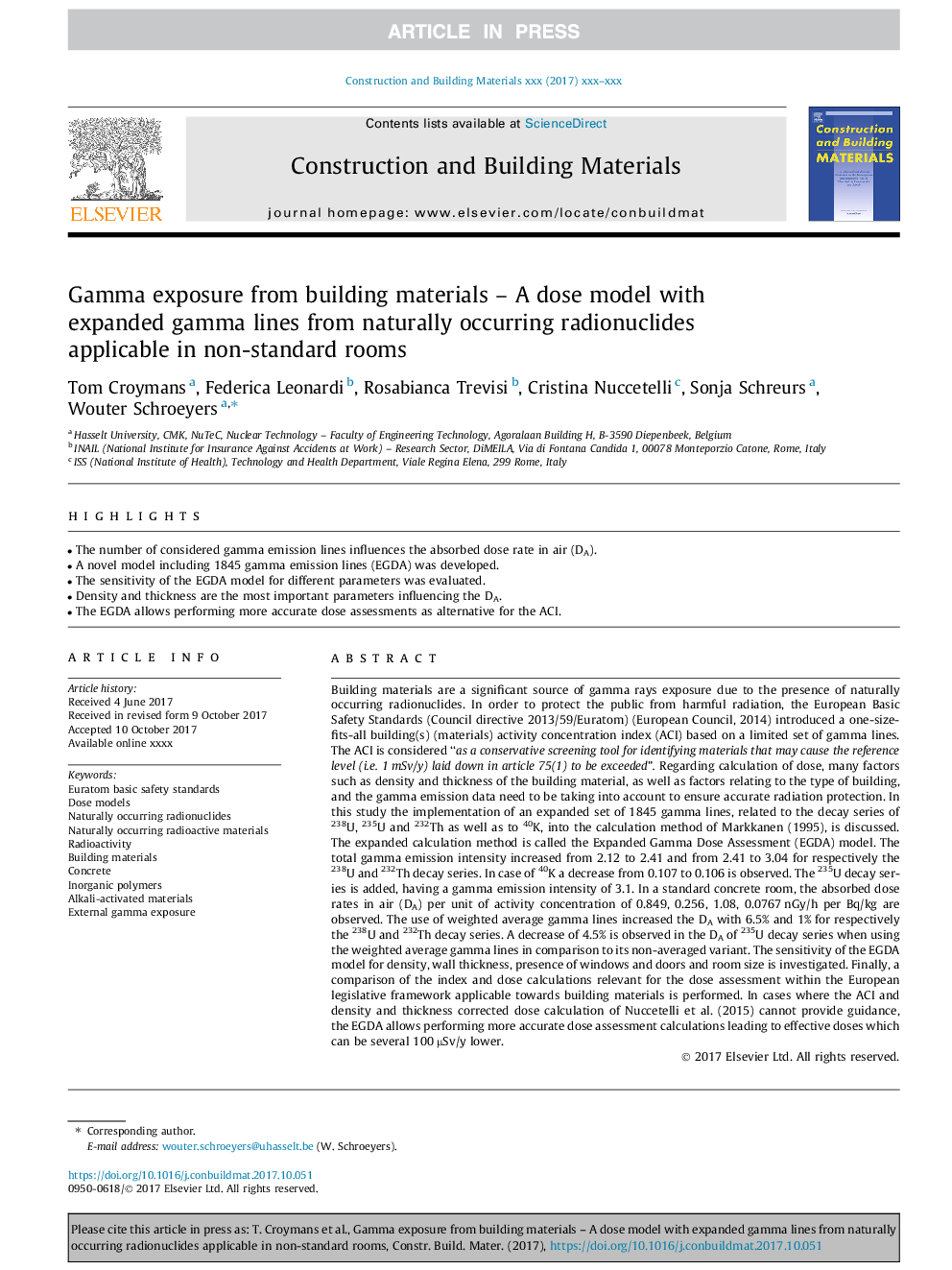| کد مقاله | کد نشریه | سال انتشار | مقاله انگلیسی | نسخه تمام متن |
|---|---|---|---|---|
| 6717550 | 1428747 | 2018 | 11 صفحه PDF | دانلود رایگان |
عنوان انگلیسی مقاله ISI
Gamma exposure from building materials - A dose model with expanded gamma lines from naturally occurring radionuclides applicable in non-standard rooms
ترجمه فارسی عنوان
قرار گرفتن در معرض گاما از مصالح ساختمانی - مدل دوز با خطوط گامای گسترش یافته از رادیونوکلئید های طبیعی که در اتاق های غیر استاندارد
دانلود مقاله + سفارش ترجمه
دانلود مقاله ISI انگلیسی
رایگان برای ایرانیان
کلمات کلیدی
استانداردهای ایمنی پایه یورو، مدلهای دز طبیعی رادیونوکلئید، مواد طبیعی رادیواکتیو، رادیواکتیویته، مصالح ساختمانی، بتن، پلیمرهای معدنی، مواد فعال فعال قلیایی، قرار گرفتن در معرض گامای خارجی،
Concrete - بتن، بتونNaturally occurring radionuclides - به طور طبیعی رادیونوکلئیدRadioactivity - رادیواکتیویتهBuilding materials - مصالح ساختمانیNaturally occurring radioactive materials - مواد طبیعی رادیواکتیو طبیعی استAlkali-activated materials - مواد فعال فعال قلیاییInorganic polymers - پلیمرهای معدنی
موضوعات مرتبط
مهندسی و علوم پایه
سایر رشته های مهندسی
مهندسی عمران و سازه
چکیده انگلیسی
Building materials are a significant source of gamma rays exposure due to the presence of naturally occurring radionuclides. In order to protect the public from harmful radiation, the European Basic Safety Standards (Council directive 2013/59/Euratom) (European Council, 2014) introduced a one-size-fits-all building(s) (materials) activity concentration index (ACI) based on a limited set of gamma lines. The ACI is considered “as a conservative screening tool for identifying materials that may cause the reference level (i.e. 1â¯mSv/y) laid down in article 75(1) to be exceeded”. Regarding calculation of dose, many factors such as density and thickness of the building material, as well as factors relating to the type of building, and the gamma emission data need to be taking into account to ensure accurate radiation protection. In this study the implementation of an expanded set of 1845 gamma lines, related to the decay series of 238U, 235U and 232Th as well as to 40K, into the calculation method of Markkanen (1995), is discussed. The expanded calculation method is called the Expanded Gamma Dose Assessment (EGDA) model. The total gamma emission intensity increased from 2.12 to 2.41 and from 2.41 to 3.04 for respectively the 238U and 232Th decay series. In case of 40K a decrease from 0.107 to 0.106 is observed. The 235U decay series is added, having a gamma emission intensity of 3.1. In a standard concrete room, the absorbed dose rates in air (DA) per unit of activity concentration of 0.849, 0.256, 1.08, 0.0767â¯nGy/h per Bq/kg are observed. The use of weighted average gamma lines increased the DA with 6.5% and 1% for respectively the 238U and 232Th decay series. A decrease of 4.5% is observed in the DA of 235U decay series when using the weighted average gamma lines in comparison to its non-averaged variant. The sensitivity of the EGDA model for density, wall thickness, presence of windows and doors and room size is investigated. Finally, a comparison of the index and dose calculations relevant for the dose assessment within the European legislative framework applicable towards building materials is performed. In cases where the ACI and density and thickness corrected dose calculation of Nuccetelli et al. (2015) cannot provide guidance, the EGDA allows performing more accurate dose assessment calculations leading to effective doses which can be several 100â¯ÂµSv/y lower.
ناشر
Database: Elsevier - ScienceDirect (ساینس دایرکت)
Journal: Construction and Building Materials - Volume 159, 20 January 2018, Pages 768-778
Journal: Construction and Building Materials - Volume 159, 20 January 2018, Pages 768-778
نویسندگان
Tom Croymans, Federica Leonardi, Rosabianca Trevisi, Cristina Nuccetelli, Sonja Schreurs, Wouter Schroeyers,
